Visiting the Mesa Verde National Park is the next stop in our series Off the Beaten Path. We reach the state of Colorado, in the southwestern portion of the United States.
Although Mesa Verde is part of the American National Parks system, its isolation has made it far less well known among world travelers. Today the site is known to possess more than 4,300 archaeological points of interest, including 600 cliff dwellings, spread over 52,485 acres (21,240 ha).
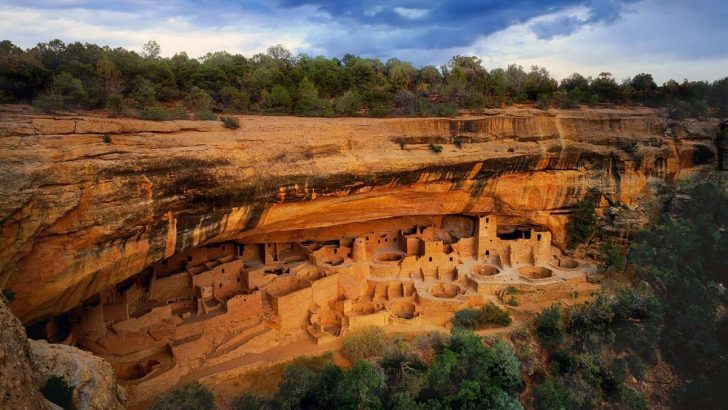
Cliff Palace At Mesa Verde National Park
A World Heritage Site, the park was established by President Theodore Roosevelt in 1906, near the Four Corners region where Arizona, Colorado, New Mexico and Utah meet.
It remains the largest archaeological preserve in the United States. Cliff Palace located within the park, is considered the largest cliff dwelling in North America.
Mesa Verde translated as green table in Spanish, offers a glimpse of what life was like for the Ancestral Pueblo people who resided in the area for some 700 years. A civilization was created and thrived here during the years encompassing 600 to 1300 C.E.
Evidence exists that indicates that the first human habitation of the area began as early as 7500 BCE.
This was on a seasonal basis by a group of nomadic Paleo-Indians, known locally as the Foothills Mountain Complex. A variety of projectile points prove their existence. These migrants were part of the Clovis culture and Folsom tradition.
Later, a new group arrived known as the Archaic people.
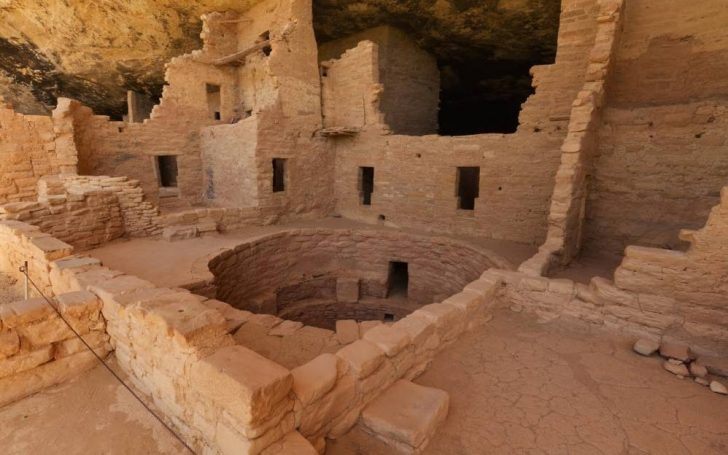
Mesa Verde
They soon established semi-permanent rock shelters in and around the mesa area. By 1000 BCE, the Basketmaker culture had emerged from this population. The Ancestral Puebloans trace their ancestry to these people and can be recognized as a distinct society by 750 CE.
The last Archaic period was marked by an increase in trade of exotic materials. This is known because of the importation and use of materials like abalone, marine shells,obsidian and turquoise,which was fashioned to create jewelry and weapons for hunting.
Rock art became popular with the people, but the people still lived in rudimentary homes made out of wood and mud.
The move into sustained agriculture would end this early phase of dwelling types, that would soon be followed by more permanent stone structures.
The majority of Mesa Verdeans earned their living through a combination of hunting and gathering along with subsistence farming. Crops raised included beans, corn and varieties of squash.
The first pueblos would be built around 650 CE. It would be near the end of the 12th century, that the now famous massive cliff dwellings would be constructed.
However, by 1285 the area was almost entirely abandoned. It is thought the populace had moved further south, to regions that are today located in Arizona and New Mexico. These new sites include Pajarito Plateau, Rio Chama and Santa Fe.
We are able to give a precise date, because through the use of dendrochronology, it can be determined that the last tree felled in the area used in construction was in 1281 CE.
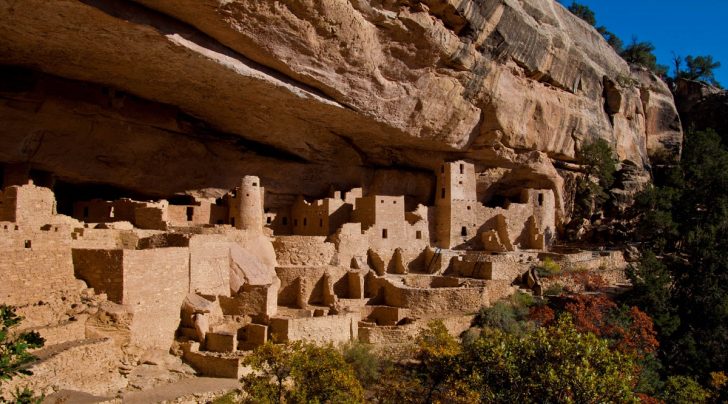
Mesa Verde Park
Why did the Puebloans abandon Mesa Verde? There is no definitive answer, except to presume it must have been environmental. The assumption is a series of intense and extended droughts through the years 1276 to 1299, made farming impossible for the growing number of inhabitants.
The change in climate known to archaeologists as the Great Drought, would of caused social instability and disorder in the close knit communities, forcing more radical plans for action.
Periodic warfare had occurred on the mesa throughout the 13th century. However during the last decades, with the ongoing shortages of food caused by changing weather patterns, conflict erupted between competing clans. This led to burnings and massacres throughout the region.
Archaeological evidence exists supporting acts of violence and even cannibalism,as the overall situation became more desperate in the region of Mesa Verde. There is also indications of outside attack during this turbulent period, right before the mass evacuation that would occur shortly after.
In more recent times Mexican-Spanish missionaries traveled through the region in 1776, but failed to rediscover the ancient stone villages.
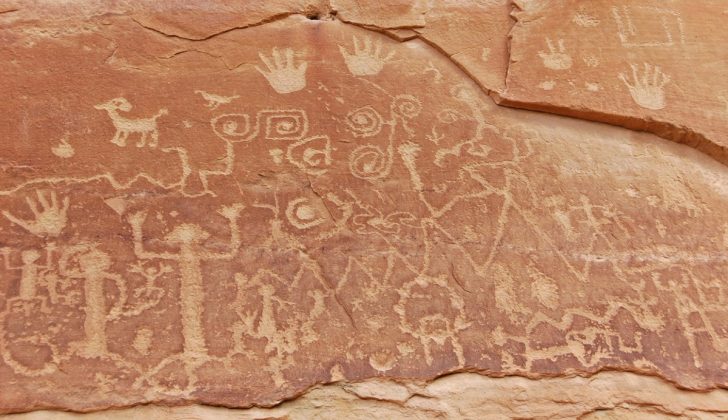
Mesa Verde Petroglyphs
Two treaties in 1868 and 1873 between the United States and the Utes, designated most of the area that today comprises the park as part of their ancestral homeland. These are a native people that have traditionally inhabited this part of Colorado. Although the Utes were aware of the cliff dwellings they did not occupy them, since they were considered scared ancestral sites.
The size of the hereditary Utes homeland would be later further reduced.
Occasional trappers and prospectors did visit during these years. John Moss one of the latter, made his observations know in 1873. It was he, who led the imminent photographer William Henry Jackson through Mancos Canyon to Mesa Verde. A geologist by the name of William H. Holmes, would follow in 1875.
The reports from these individuals, would be included in the Hayden Survey, which was a federal financed effort to explore the American West. Proposals to study the Mesa Verde site followed.
Virginia McClurg a journalist, visited Mesa Verde in 1882 and 1885. Her further discoveries of sites in the area, began the movement to preserve and protect these ancient dwellings. Thus began the modern interest in the culture of the Puebloans.
The most famous site known as Cliff Palace, would be rediscovered by cattle rancher Richard Wetherill in 1888. He was told of the general location by the Utes. Photographer and author Frederick H. Chapin would visit the Wetherills in 1889 and 1890. He would describe what he had seen in an 1890 article and a book that followed in 1892.
It was the visit of Gustav Nordenskiold son of a famous polar explorer in 1891, that changed the public perception of Mesa Verde. His collection of numerous artifacts and their removal to Sweden and finally to the National Museum of Finland, initiated new efforts to protect and preserve the historical sites of the area.
Today, three of the cliff dwellings on the popular Chapin Mesa are open to the public. These are about 20 miles (32km) from the visitor center.
Balcony House, Long House and Cliff Palace all require tickets for ranger guided tours.
Many other ancient stone habitations are visible from the road, but are not open to tourists.
How To Get There
The park is located in Southwestern Colorado. The entrance can be accessed along Highway 160 between the towns of Cortez and Mancos. Mesa Verde is about 35 miles west of Durango, Colorado. You will need some kind of vehicle to visit the park, because of the distances between the major sites.
Upon entering the park,the first cliff viewing is about 21 miles up the road. It will take about 45 minutes to arrive to this point. The road providing access is narrow, steep and winding, so you will need to drive carefully.
The nearest airports are located in Cortez and Durango which are both located in Colorado. Another option is Farmington, New Mexico.
Hours of Operations
The park is open daily year round. However, the visitor center and museum are closed on Thanksgiving, Christmas and New Year’s Day. Daily admittance will vary with the season, but usually will open either 8:00 am or 8:30 am and will close between 4:30 pm and 5:00 pm.
The extended hours available through peak season (May 27 through September 5), is from 7:30 am to 7:00 pm.
The campgrounds and cafes are open from the middle to end of April, to the middle to end of October. The only exception is the Spruce Tree Terrace Cafe which is open every day, except for the three aforementioned holidays.
Admission and Entrance Fees
If you wish to visit the park during the spring or fall, admission will cost $10 USD. (United States Dollar). Peak season for tourists, which is during the summer months, the cost rises to $15 USD.
Those individuals coming by motorcycle, bicycle, and non commercial buses, are permitted to enter the park for $5.00 USD, except during peak season where the price is $8.00 USD.
The entrance fee once purchased, is good for up to 7 days for all visitors.
One can also purchase a Mesa Verde annual pass for $30.00 USD, that permits unlimited visits for a full year.
Commercial tours will have a different price schedule.
Lodging
If you wish to stay in the park, the Far View Lodge is open from April 14 to October 23 in 2016. These are an estimate of dates for subsequent years. Reservations can be made online http://www.visitmesaverde.com/accommodations/far-view-lodge.aspx or by phone (1-800-449-2288). The facility offers panoramic views into Arizona, Colorado and New Mexico. Although there are no televisions provided, Wi-Fi is complimentary. All other major amenities are available, regardless of room assignment.
By Jeffrey Hagenmeier

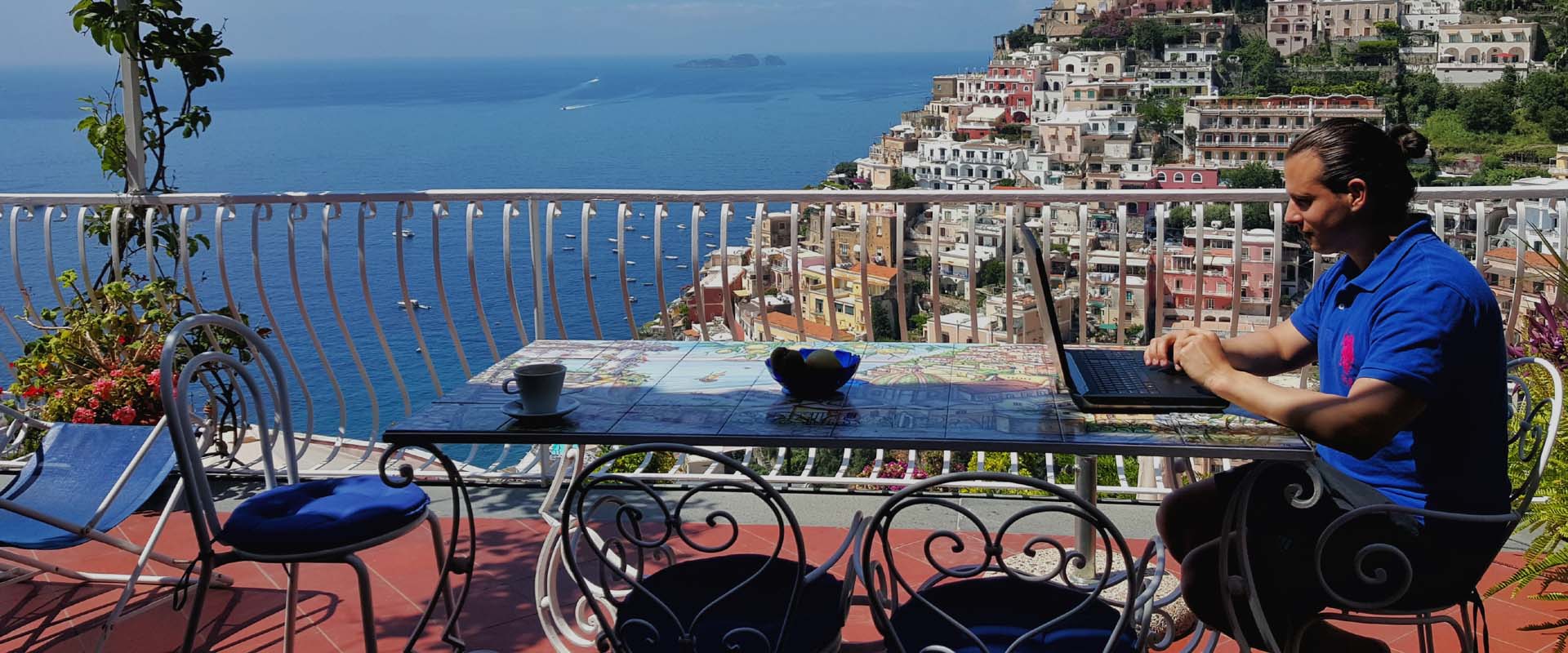
Yes, I’m agree with you!!!!